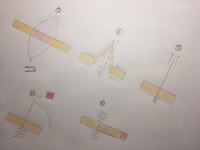Every year there are countless instances, in both civilian and military situations, where a patient sustains a gaping wound: One where the edges of the wound are being pulled away from one another. This is a common sight for first responders and in most cases these are dealt with using sutures and bandages. This approach is effective, but it is time consuming and there is an inherent risk to the first responder using a suture needle, covered in blood, in a high-stress scenario (needle-stick injuries for example).
This innovation would allow for a non-invasive, low risk and quick alternative to the use of sutures for gaping wounds. The product consists of a length bandage material with specifically placed adhesive surfaces to allow anchor points on the skin. The outer adhesive surfaces are exposed and placed at the edge of the gaping wound, with the length of the bandage material spanning the wound. From here, the centre of the product is pulled up and away from the wound whilst the base of the bandage is pinched. This will bring the edges of the wound into alignment. The vertical length of bandage can then be folded down and adhered to the skin to keep the wound shut. This is a faster way of closing gaping wounds which does not expose the patient or the doctor/ paramedic to any risks from a potentially contaminated needle. This will allow first responders to quickly close wounds that would otherwise pose and infection risk, and subsequently allow more time for management of the patient’s more life-threatening injuries. This would also allow for a less visible scar from the injury. The closed wound could then be sutured in a clinical setting if necessary. This product may face limitations for gaping wounds on hairy areas of skin, though these areas could be shaved, as is common practice with public-use defibrillator kits. More than one may have to be used for larger wounds.
The manufacture of this product is low cost as the parts already exist and are implemented in the common plaster (UK)/ Band-Aid (USA). Since this innovation requires no metal, careful packing or delicate attachment of suture thread, the manufacturing costs, and labour requirements, of this product are significantly less than that of an emergency suture kit.
This product would find most use in emergency medical situations where time is of the essence and gaping wounds pose an infection and bleeding risk. Today, emergency services in the UK do not have something akin to this product, instead using suture kits. There is an identifiable gap in the market for a safe, effective and cheap alternative for suture kits in the acute emergency setting.
Like this entry?
-
About the Entrant
- Name:Jack Sharman
- Type of entry:individual
- Patent status:none





